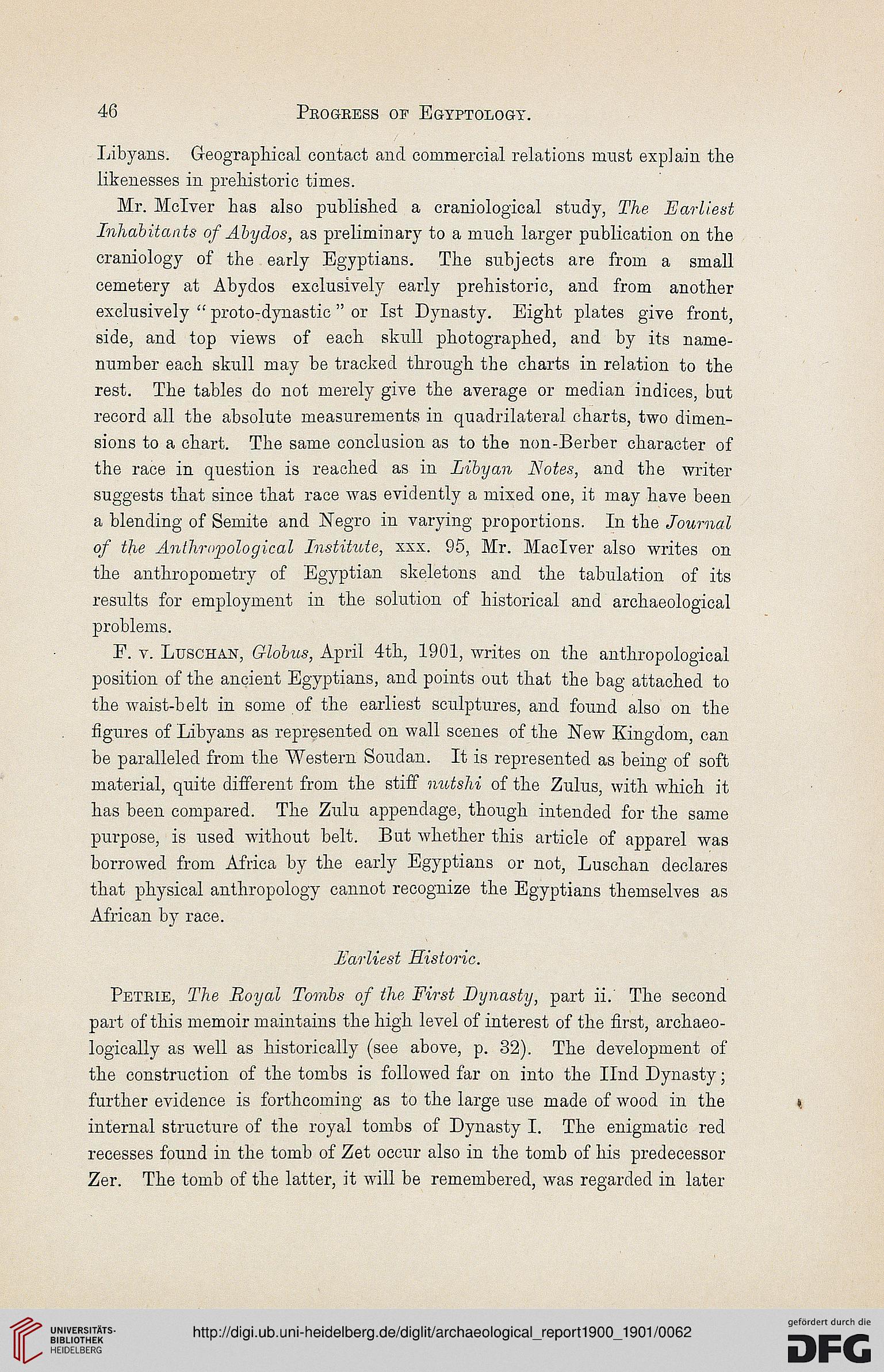46
Progress oe Egyptology.
Libyans. Geographical contact and commercial relations must explain the
likenesses in prehistoric times.
Mr. Mclver has also published a craniological study, The Earliest
Inhabitants of Abydos, as preliminary to a much larger publication on the
craniology of the early Egyptians. The subjects are from a small
cemetery at Abydos exclusively early prehistoric, and from another
exclusively " proto-dynastic " or 1st Dynasty. Eight plates give front,
side, and top views of each skull photographed, and by its name-
number each skull may be tracked through the charts in relation to the
rest. The tables do not merely give the average or median indices, but
record all the absolute measurements in quadrilateral charts, two dimen-
sions to a chart. The same conclusion as to the non-Berber character of
the race in question is reached as in Libyan Notes, and the writer
suggests that since that race was evidently a mixed one, it may have been
a blending of Semite and Negro in varying proportions. In the Journal
of the Anthropological Institute, xxx. 95, Mr. Maclver also writes on
the anthropometry of Egyptian skeletons and the tabulation of its
results for employment in the solution of historical and archaeological
problems.
E. v. Luschan, Globus, April 4th, 1901, writes on the anthropological
position of the ancient Egyptians, and points out that the bag attached to
the waist-belt in some of the earliest sculptures, and found also on the
figures of Libyans as represented on wall scenes of the New Kingdom, can
be paralleled from the Western Soudan. It is represented as being of soft
material, quite different from the stiff nutshi of the Zulus, with which it
has been compared. The Zulu appendage, though intended for the same
purpose, is used without belt. But whether this article of apparel was
borrowed from Africa by the early Egyptians or not, Luschan declares
that physical anthropology cannot recognize the Egyptians themselves as
African by race.
Earliest Historic.
Petrie, The Royal Tombs of the First Dynasty, part ii. The second
part of this memoir maintains the high level of interest of the first, archaeo-
logically as well as historically (see above, p. 32). The development of
the construction of the tombs is followed far on into the Ilnd Dynasty;
further evidence is forthcoming as to the large use made of wood in the ».
internal structure of the royal tombs of Dynasty I. The enigmatic red
recesses found in the tomb of Zet occur also in the tomb of his predecessor
Zer. The tomb of the latter, it will be remembered, was regarded in later
Progress oe Egyptology.
Libyans. Geographical contact and commercial relations must explain the
likenesses in prehistoric times.
Mr. Mclver has also published a craniological study, The Earliest
Inhabitants of Abydos, as preliminary to a much larger publication on the
craniology of the early Egyptians. The subjects are from a small
cemetery at Abydos exclusively early prehistoric, and from another
exclusively " proto-dynastic " or 1st Dynasty. Eight plates give front,
side, and top views of each skull photographed, and by its name-
number each skull may be tracked through the charts in relation to the
rest. The tables do not merely give the average or median indices, but
record all the absolute measurements in quadrilateral charts, two dimen-
sions to a chart. The same conclusion as to the non-Berber character of
the race in question is reached as in Libyan Notes, and the writer
suggests that since that race was evidently a mixed one, it may have been
a blending of Semite and Negro in varying proportions. In the Journal
of the Anthropological Institute, xxx. 95, Mr. Maclver also writes on
the anthropometry of Egyptian skeletons and the tabulation of its
results for employment in the solution of historical and archaeological
problems.
E. v. Luschan, Globus, April 4th, 1901, writes on the anthropological
position of the ancient Egyptians, and points out that the bag attached to
the waist-belt in some of the earliest sculptures, and found also on the
figures of Libyans as represented on wall scenes of the New Kingdom, can
be paralleled from the Western Soudan. It is represented as being of soft
material, quite different from the stiff nutshi of the Zulus, with which it
has been compared. The Zulu appendage, though intended for the same
purpose, is used without belt. But whether this article of apparel was
borrowed from Africa by the early Egyptians or not, Luschan declares
that physical anthropology cannot recognize the Egyptians themselves as
African by race.
Earliest Historic.
Petrie, The Royal Tombs of the First Dynasty, part ii. The second
part of this memoir maintains the high level of interest of the first, archaeo-
logically as well as historically (see above, p. 32). The development of
the construction of the tombs is followed far on into the Ilnd Dynasty;
further evidence is forthcoming as to the large use made of wood in the ».
internal structure of the royal tombs of Dynasty I. The enigmatic red
recesses found in the tomb of Zet occur also in the tomb of his predecessor
Zer. The tomb of the latter, it will be remembered, was regarded in later




